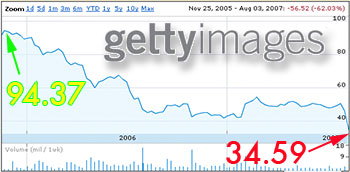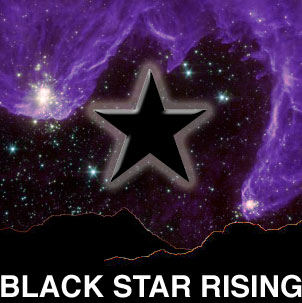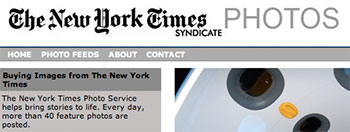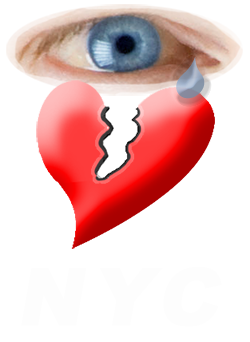I told you so? No, not really. (Well, maybe, sort of)
 Recently, I posted an article about shorting Getty's stock as the only good short-sighted idea I could find. I was quickly criticized by Dan Heller both on my comments, and in a lengthy blog post. Interestingly enough, it was his Getty commentaries (in general) that got him hired as a stock analyst. Previously, Heller said he didn't see a downside and that the stock would stay the course. While I have never been hired as a stock analyst before, and wouldn't know where to begin if I was, perhaps they called the wrong guy? Heller's 8/2 blog entry is missing something - an acknowledgement that, either by luck or by learn-ed observation, I got it right. Getty's stock plummeted almost 20% this past week, and over this weekend, sits at $34.59. With more than one fund having millions invested in Getty, those folks still holding GYI are have taken a huge hit and are probably pretty upset. Could it have cut the other way? Sure. Could it drop again at the next quarterly report when the new website is finally launched? Quite probably, given that, in the final stretch, they fired the person incharge of that process, as Daryl Lang, over at PDN, reported in this interesting article that's a must read, along with previous related posts worth reading for further insight. Silly decision on Getty's part.
Recently, I posted an article about shorting Getty's stock as the only good short-sighted idea I could find. I was quickly criticized by Dan Heller both on my comments, and in a lengthy blog post. Interestingly enough, it was his Getty commentaries (in general) that got him hired as a stock analyst. Previously, Heller said he didn't see a downside and that the stock would stay the course. While I have never been hired as a stock analyst before, and wouldn't know where to begin if I was, perhaps they called the wrong guy? Heller's 8/2 blog entry is missing something - an acknowledgement that, either by luck or by learn-ed observation, I got it right. Getty's stock plummeted almost 20% this past week, and over this weekend, sits at $34.59. With more than one fund having millions invested in Getty, those folks still holding GYI are have taken a huge hit and are probably pretty upset. Could it have cut the other way? Sure. Could it drop again at the next quarterly report when the new website is finally launched? Quite probably, given that, in the final stretch, they fired the person incharge of that process, as Daryl Lang, over at PDN, reported in this interesting article that's a must read, along with previous related posts worth reading for further insight. Silly decision on Getty's part.
For those analysts trolling for insights - here's one, for free: When your profits are based upon ad clients and rights-managed image licensing, with an average license of around $200 or so, and you are seeing a decline in that model because you also now are the proud owner of iStockPhoto, where the license is about $1, and that model is growing while the rights-managed model is shrinking, take a hint - Jupiter Images stock (JUPM) just sunk below the $7 mark - you should be lucky that GYI is where it is right now.
One of the problems is, I wasn't actually saying you should short the stock when I posted it. It was an analysis of the stock's past performance more than anything else, and it was a critical commentary on the contract conditions under which freelancers produce work for Getty. I was suggesting that working for Getty is a short-sighted idea, that is bad, and that, shorting their stock was about the only short-sighted idea I could find. It was a funny play on words to make the point about how bad GYI is for the field of photography that they rely on. I hadn't shorted it before, and I didn't short it this past week. As they always post as a disclaimer "past performance is not an indicator of the future...".
Getty has given validation to the istockphoto company, and more importantly, it's model, and is further encouraging other companies to buy up other microstock competitors. In addition, while high end clients may have gone to Getty for imagery before, and avoided the cheaper options, now those RM clients are far far more comfortable avoiding paying the "front of house white tablecloth prices" for a meal, and instead, going around back to the alley entrance to get the same meal on a paperplate for a fraction of the price.
Try this - Go to the Getty Images site, and, say, you are looking for a photo of The White House. Under "news editorial", not a single photo on the front page, with a search return (as of today) for 'the white house' - 46495 images found, is of the actual White House. It's all photos of the President. Changing to "all editorial" instead of "news", yields 51614 images found, but again, no photo of the actual building I am searching for.
Finally, when searching the "creative" division, I get 127 images found. Really? Only 127? The first page of about fifty images yields only 30 images that fit the bill, and there are mis-identified images as well, including one of the Capitol, and one of a field of Cactus with a white building (house?) at the top of the frame.
Go to istockphoto, and the first three images from the home page search are what is being sought, including this one - The White House on iStockPhoto.
This image on istockphoto, submitted by DHuss, looks remarkably like this one submitted as a part of the National Geographic Society's collection, photographed by Richard Nowitz.
This one, on the Getty Images site shows the White House at dusk. So does this one, on iStockPhoto.
Interestingly enough, the iStockphoto site yielded more to choose from (182), and the right results, first.
A search for "golden gate bridge" on Getty yields 555 images. An Istockphoto search? 870. Both front pages yield perfectly usable photos, sharp, clear, all angles, and so forth.
I could go on, there are countless examples, you get the point. While Getty isn't revealing how much of their RM clients are turning to the IStockPhoto solutions, clearly, the content is there for the picking, and, based upon the White House example above, iStockPhoto is actually a better resource.
I've been criticized by others for suggesting that what people are doing, and the microstock model in general, is bad for the field of professional photographers. That doesn't make what I am saying false, people just are choosing to bury their heads in the sand. Consider this - when a paper or lumber company plants seedlings as they cut down 100-year-old trees, they will never see that benefit themselves, not in their, nor their grandchildren's lifetimes, but it is "priming the pump" for future forestry opportunities. This is a long-term good idea. Getty's (and they are, by no means, alone) way of paying photographers diminishes the creative stock, and they are depleating it faster than they are replentishing it. There is no reforestation. Getty is the big dog in town, and has a responsibility to "reforest" the creative population, and protect their current assets. They are not doing this to support long-term growth, they are doing this to appeal to Wall Street demands. Next up? Well, let's see - when a stock tanks from a high of over 90, to below 40, with no signs of a resurgence, and only a hope of stopping the blood-letting, there needs to be more of a transfusion than the dumping of the website leadership, a wholesale new CEO is needed. Jonathan Klein needs to head to the unemployment line - perhaps the next 1.5 million dollar glitch needs to be related to his salary ( Andy Goetze over at Stock Photo Talk has a 2004 article giving you some ideas as to his past compensation.)
Forbes reported what happened at GYI. An AP article notes "Baird analyst Steven Ashley cut his price target...He also noted that demand is shifting toward less expensive images....", and then went on to say GYI was still attractive "...since most of its images are owned by independent photographers and are created at their expense."
Right. The indpendents still own their own work, and can sever ties with Getty under their contract terms. That means that Getty could have a lot of empty hard drive space and idle servers, which is why they are working very hard to secure wholey-owned content which can't walk on a whim.
Thanks to Stanley Rowin for writing here about Heller's blaming "human behavior", and noting that perhaps, I got it right. Rowin points out "...it’s the stupid humans that make up the market force that determine how photography is priced, no longer the photographers." Right Stan - the bean counters cannot possibly know what goes into being a photographer, the costs, and thus, when properly schooled in their own self worth and costs-of-being-in-business, a photographer can properly value their own work. There's one exception I know of - John. He's an accountant in Baltimore who is also a professional photographer - he gets the right brain and the left brain stuff!
Please post your comments by clicking the link below. If you've got questions, please pose them in our Photo Business Forum Flickr Group Discussion Threads.
 The granddaddy of the royalty-free (aka RF) world is Photodisc, who's owners have passed her around as some cheap trick to serve a shifting master. Jim Pickerell
The granddaddy of the royalty-free (aka RF) world is Photodisc, who's owners have passed her around as some cheap trick to serve a shifting master. Jim Pickerell  While blogs should not be local, sometimes, a local issue has national (ne, international) implications. Previously
While blogs should not be local, sometimes, a local issue has national (ne, international) implications. Previously  The subjects offices were in their "towne center" and we opted for an outside portrait. While I was setting up my lightstand and power pack, a private security guard approached, and told me I needed permission to make photos there. I showed him my press credentials, told him the subject's company's name was on the top of the office building behind him. "You gotta get permission", came his response. I caught a break though, because I'd not been a smart aleck and I showed him my press credential, and he said "I'm going to walk over there where I have better reception on my cell phone, and call someone. Hopefully, you'll be done by the time I get back", and I was. The photo (to the left), isn't the best, nor was it the one chosen for the story, but it's illustrative of the environment.
The subjects offices were in their "towne center" and we opted for an outside portrait. While I was setting up my lightstand and power pack, a private security guard approached, and told me I needed permission to make photos there. I showed him my press credentials, told him the subject's company's name was on the top of the office building behind him. "You gotta get permission", came his response. I caught a break though, because I'd not been a smart aleck and I showed him my press credential, and he said "I'm going to walk over there where I have better reception on my cell phone, and call someone. Hopefully, you'll be done by the time I get back", and I was. The photo (to the left), isn't the best, nor was it the one chosen for the story, but it's illustrative of the environment. Making news in the past few days is Digital Railroad's sales team, led by the
Making news in the past few days is Digital Railroad's sales team, led by the  Well, it seems, everyone's up in arms about
Well, it seems, everyone's up in arms about 